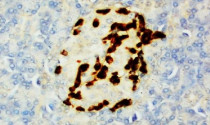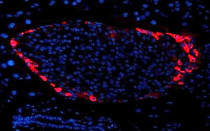ARG43789
anti-Glucagon antibody [K79bB10]
anti-Glucagon antibody [K79bB10] for IHC-Formalin-fixed paraffin-embedded sections and Human,Mouse,Rat,Rabbit
Overview
| Product Description | Mouse Monoclonal antibody [K79bB10] recognizes Glucagon |
|---|---|
| Tested Reactivity | Hu, Ms, Rat, Rb |
| Tested Application | IHC-P |
| Specificity | The antibody reacts proglucagon only, and it can't react to Glicentin, Oxyntomodulin, active Glucagon, GLP1 and GLP2. |
| Host | Mouse |
| Clonality | Monoclonal |
| Clone | K79bB10 |
| Isotype | IgG |
| Target Name | Glucagon |
| Antigen Species | Pig |
| Immunogen | Polymerized porcine glucagon. |
| Conjugation | Un-conjugated |
| Alternate Names | GLP-1; GLP-2; GLP1; OXY; GLP2; Glucagon; OXM; 7-37; 7-36; Incretin hormone; GRPP |
Application Instructions
| Application Suggestion |
|
||||
|---|---|---|---|---|---|
| Application Note | * The dilutions indicate recommended starting dilutions and the optimal dilutions or concentrations should be determined by the scientist. | ||||
| Positive Control | Rat Pancreas |
Properties
| Form | Liquid |
|---|---|
| Purification | Unpurified Mouse ascites fluid. |
| Buffer | Mouse ascites fluid with 1.2% sodium acetate, 2% BSA and 0.01% sodium azide. |
| Preservative | 0.01mg sodium azide |
| Stabilizer | 2mg BSA |
| Concentration | 0.1 mg/ml |
| Storage Instruction | For continuous use, store undiluted antibody at 2-8°C for up to a week. For long-term storage, aliquot and store at -20°C or below. Storage in frost free freezers is not recommended. Avoid repeated freeze/thaw cycles. Suggest spin the vial prior to opening. The antibody solution should be gently mixed before use. |
| Note | For laboratory research only, not for drug, diagnostic or other use. |
Bioinformation
| Database Links | |
|---|---|
| Gene Symbol | GCG |
| Gene Full Name | glucagon |
| Background | The protein encoded by this gene is actually a preproprotein that is cleaved into four distinct mature peptides. One of these, glucagon, is a pancreatic hormone that counteracts the glucose-lowering action of insulin by stimulating glycogenolysis and gluconeogenesis. Glucagon is a ligand for a specific G-protein linked receptor whose signalling pathway controls cell proliferation. Two of the other peptides are secreted from gut endocrine cells and promote nutrient absorption through distinct mechanisms. Finally, the fourth peptide is similar to glicentin, an active enteroglucagon. [provided by RefSeq, Jul 2008] |
| Function | Glucagon plays a key role in glucose metabolism and homeostasis. Regulates blood glucose by increasing gluconeogenesis and decreasing glycolysis. A counterregulatory hormone of insulin, raises plasma glucose levels in response to insulin-induced hypoglycemia. Plays an important role in initiating and maintaining hyperglycemic conditions in diabetes. GLP-1 is a potent stimulator of glucose-dependent insulin release. Play important roles on gastric motility and the suppression of plasma glucagon levels. May be involved in the suppression of satiety and stimulation of glucose disposal in peripheral tissues, independent of the actions of insulin. Have growth-promoting activities on intestinal epithelium. May also regulate the hypothalamic pituitary axis (HPA) via effects on LH, TSH, CRH, oxytocin, and vasopressin secretion. Increases islet mass through stimulation of islet neogenesis and pancreatic beta cell proliferation. Inhibits beta cell apoptosis. GLP-2 stimulates intestinal growth and up-regulates villus height in the small intestine, concomitant with increased crypt cell proliferation and decreased enterocyte apoptosis. The gastrointestinal tract, from the stomach to the colon is the principal target for GLP-2 action. Plays a key role in nutrient homeostasis, enhancing nutrient assimilation through enhanced gastrointestinal function, as well as increasing nutrient disposal. Stimulates intestinal glucose transport and decreases mucosal permeability. Oxyntomodulin significantly reduces food intake. Inhibits gastric emptying in humans. Suppression of gastric emptying may lead to increased gastric distension, which may contribute to satiety by causing a sensation of fullness. Glicentin may modulate gastric acid secretion and the gastro-pyloro-duodenal activity. May play an important role in intestinal mucosal growth in the early period of life. [UniProt] |
| Cellular Localization | Secreted. |
| Calculated MW | 21 kDa |
| PTM | Proglucagon is post-translationally processed in a tissue-specific manner in pancreatic A cells and intestinal L cells. In pancreatic A cells, the major bioactive hormone is glucagon cleaved by PCSK2/PC2. In the intestinal L cells PCSK1/PC1 liberates GLP-1, GLP-2, glicentin and oxyntomodulin. GLP-1 is further N-terminally truncated by post-translational processing in the intestinal L cells resulting in GLP-1(7-37) GLP-1-(7-36)amide. The C-terminal amidation is neither important for the metabolism of GLP-1 nor for its effects on the endocrine pancreas. |
Images (2) Click the Picture to Zoom In
-
ARG43789 anti-Glucagon antibody [K79bB10] IHC-P image
Immunohistochemistry: Formalin-fixed and paraffin-embedded rat pancreas tissue stained with ARG43789 anti-Glucagon antibody [K79bB10] at 1 μg/ml. Antigen Retrieval: Heat mediated was performed using Tris/EDTA buffer pH 8.0.
-
ARG43789 anti-Glucagon antibody [K79bB10] IF image
Immunofluorescence: Mouse pancreas tissue blocked with 10% goat serum for overnight at 4°C. Tissue were stained with ARG43789 anti-Glucagon antibody [K79bB10] at 1-2μg/ml.







